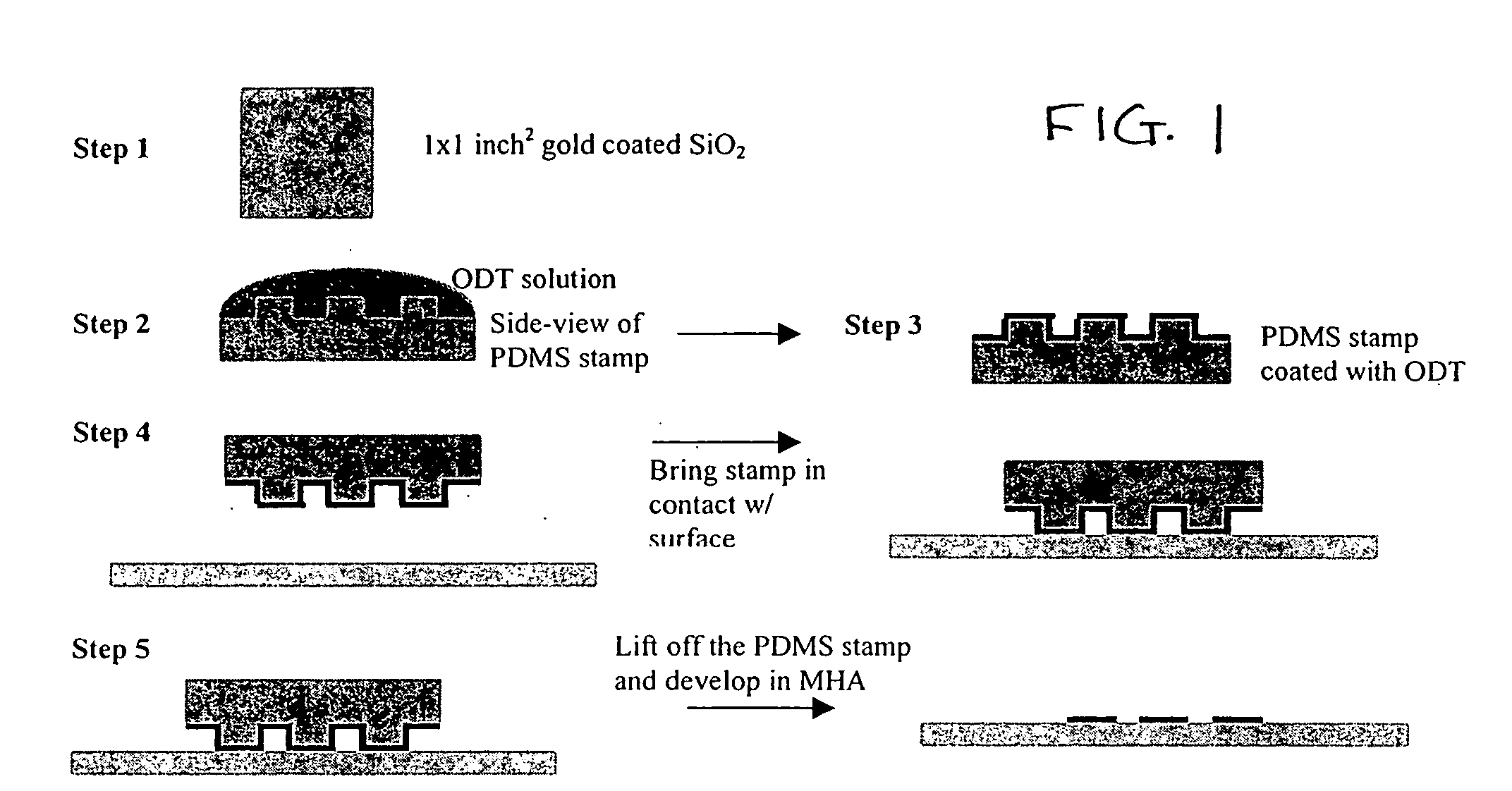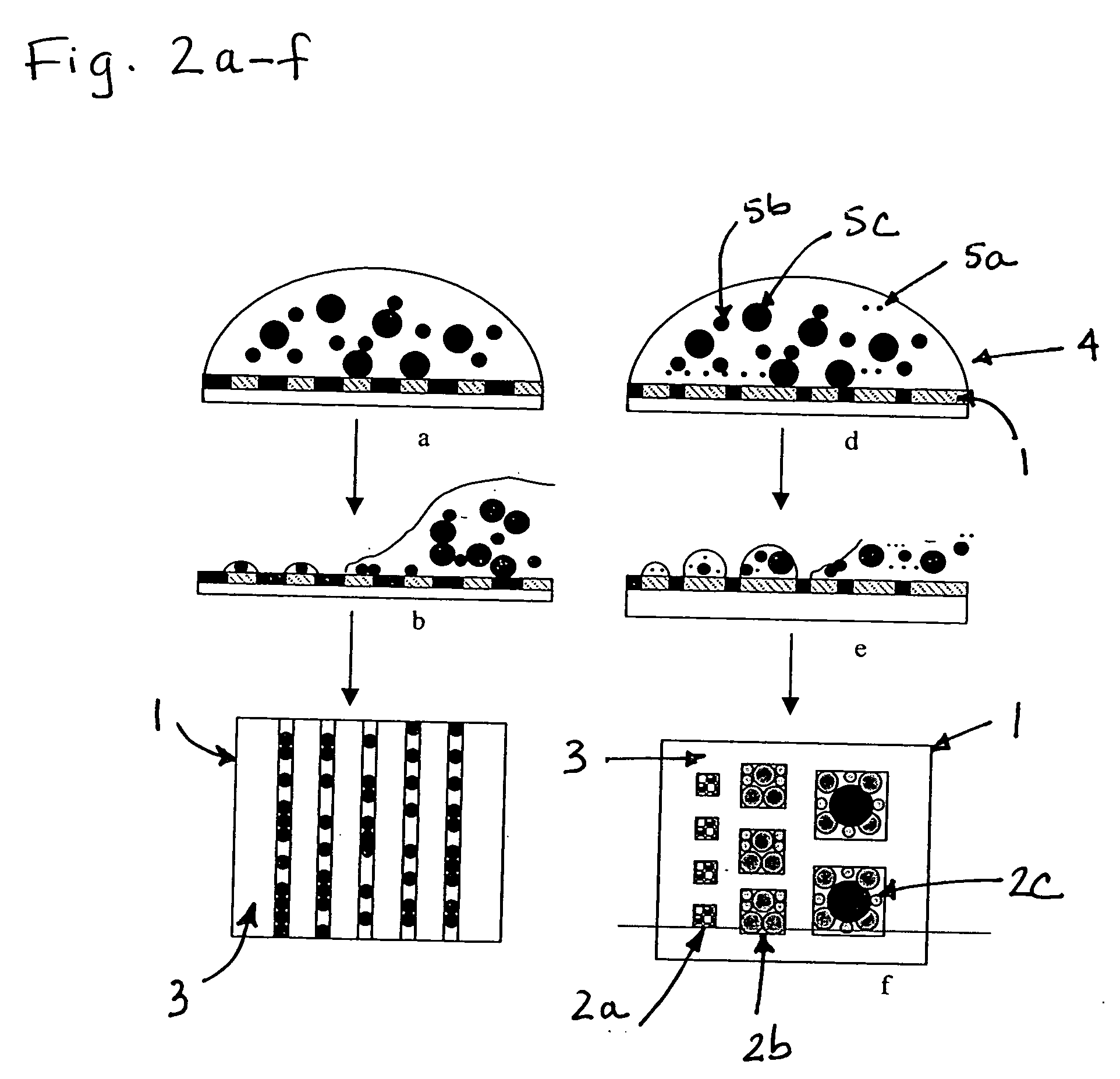Control of the spatial distribution and sorting of micro-or nano-meter or molecular scale objects on patterned surfaces
a technology patterned surfaces, which is applied in the field of control of the spatial distribution and sorting of micro-or nanometer or molecular scale objects on patterned surfaces, can solve the problems of difficult direct control of the spatial distribution and array of micro- or nanometer scale objects across large areas, and achieve the effect of easy sorting of objects by size and broad application in a range of technologies
- Summary
- Abstract
- Description
- Claims
- Application Information
AI Technical Summary
Benefits of technology
Problems solved by technology
Method used
Image
Examples
example 1
Materials:
[0076] PDMS stamp with a pattern (e.g. stripes or square grids), 1 mM solution of octadecanethiol (ODT) and 16-mercaptohexadecanoic acid (MHA) in ethanol, gold coated surface, polystyrene latex, Au nanoparticle solution (0.001% in water with a diameter of 20 nm), Nanowires, distilled water, ethanol.
Procedure:
[0077] The first step is to transfer the surfactant molecules in a pattern onto the gold surface. A schematic of this procedure is shown in FIG. 1: [0078] 1. A gold surface was obtained (e.g. 100 nm gold film coated on sublayer of chromium on a SiO2 wafer) and cut a 1 inch square portion. The surface was rinsed with ethanol and blow dried with pure nitrogen gas. [0079] 2. A PDMS stamp was obtained having the desired pattern. FIG. 6 shows a schematic illustration of the PDMS stamp used in this set of experiments. [0080] 3. The PDMS stamp was positioned with the patterned features facing upwards. The patterned face of the stamp was coated with sufficient ODT solutio...
example 2
Materials:
[0094] Substrates or thin films with patterned lyophilic surfaces formed by photolithography, soft lithography or other method, polystyrene latex, Au nanoparticle solution (0.001% in water with a diameter of 20 nm), Nanowires, Lamda DNA, Protein, polymer, distilled water.
Procedure:
[0095] The first step was to form lyophilic patterns on substrates such as silicon wafer, metal and polymer films by photolithography, e-beam lithography and soft lithography. Such methods are discussed herein, e.g. in Example 2, and can be in accordance with known methods.
[0096] The next step was to deposit the objects of interest (e.g. colloidal particles) onto the surfaces with lyophilic patterns by drop evaporating and dip coating. Drop evaporating was accomplished as follows: [0097] 1. The substrate was put into a chamber and the temperature and humidity was adjusted as required. [0098] 2. The deposited drop volume fraction of objects in solvents ranged from 10% to 0.00001%. All evapor...
example 3
[0110] A sample was prepared by evaporating a drop of 0.01 wt % mixed suspension on surfaces with 1 μm lyophilic strips and 1 μm lyophobic strip apart at 25° C. and 26% humidity. The particles in suspension comprise a mixture of particles with diameters of 800 nm and 200 nm.
[0111]FIG. 3 shows optical microscopy images of shapes formed by the mixed particles with diameters of 800 nm and 200 nm, and magnification of some regions. The excellent selectivity of the particle deposition can be seen in the magnified images. As shown, all 800 nm particles go to the edge and accumulate locally after depinning and fast evaporation (FIG. 3c, d). The 200 nm particles deposit on lyophilic regions and mimic the parent pattern (FIG. 3b).
[0112] Consider a cylinder cap of radius R with a pinned contact line, created by a fluid wedge with contact angle θ. The height of the spherical cap h is determined simply by: tanθ / 2=h / R. Here, the receding contact angle of surface with 1 μm strip is measured to ...
PUM
| Property | Measurement | Unit |
|---|---|---|
| contact angles | aaaaa | aaaaa |
| diameter | aaaaa | aaaaa |
| diameter | aaaaa | aaaaa |
Abstract
Description
Claims
Application Information
 Login to View More
Login to View More - R&D
- Intellectual Property
- Life Sciences
- Materials
- Tech Scout
- Unparalleled Data Quality
- Higher Quality Content
- 60% Fewer Hallucinations
Browse by: Latest US Patents, China's latest patents, Technical Efficacy Thesaurus, Application Domain, Technology Topic, Popular Technical Reports.
© 2025 PatSnap. All rights reserved.Legal|Privacy policy|Modern Slavery Act Transparency Statement|Sitemap|About US| Contact US: help@patsnap.com



